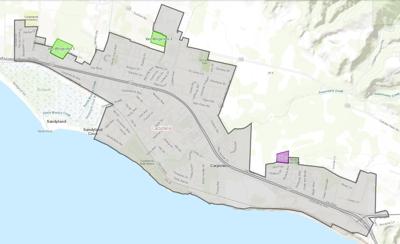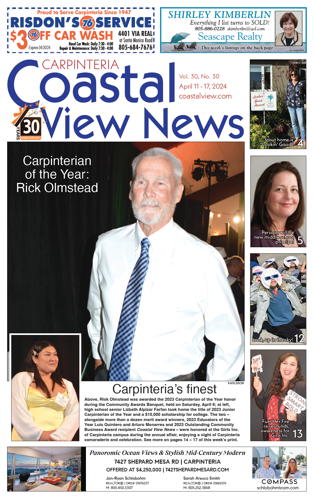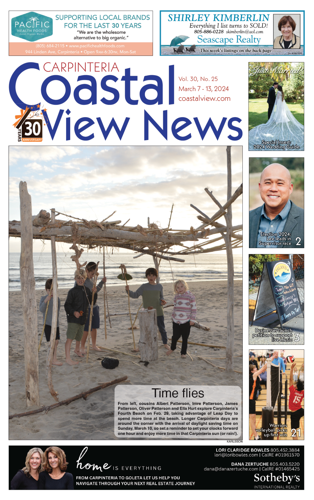New buildings are approved long before the first bulldozer shows up. Even more impactful, land use zoning decisions are often made years before any particular development is even conceived.
More than anything else, the zoning of an area controls what type of development can occur there – shopping center, office buildings, just a few houses, high-density apartments or even agriculture. There is specific zoning for each of these as well as other types of development. A decision about zoning can have more impact than any specific development proposal.
The zoning is critical, so it would seem any government decisions about it would get people riled up and filling hearing rooms. We have seen overflow crowds at City Hall for development proposals for the Carpinteria Bluffs, and we recently saw a full City Hall for the topic of live music (CVN Vol. 30, No. 28). So, for even bigger decisions that will determine what can be built somewhere, you might expect people to really turn out.
But that rarely happens. The reason is that a specific hotel proposal or an issue like live music is more immediate, more personal. Zoning is an overall plan for what type of detailed proposals will be allowed. This is not exciting stuff. It is dry, complicated, wonky, even arcane – good reading if you are having trouble sleeping.
But it is time to wake up!
For the past couple of years, every county and city in California has been working on updating their Housing Elements. This is a part of their General Plan that identifies how that community will plan for the housing it will need over the next eight years. The required amount of housing is handed down by the state of California as the Regional Housing Needs Allocation or “RHNA,” and accommodating it is not optional. The last step in the long and detailed process for the Housing Element Update is for the community to rezone areas that will need to be converted to housing to implement the plan. That is exactly where we are now for the city of Carpinteria and for Santa Barbara County.
Both the city and the county will be rezoning long lists of sites, not just one or two parcels. You can consider this to be the Mother of Them All when it comes to planning decisions that will affect the future of our community.
In the past week, the Santa Barbara County Planning Commission held hearings to discuss a list of potential rezone sites that has slightly more than the number of sites that are required. The commission eliminated a few and sent its recommendation to the Board of Supervisors, which will generate a final list in hearings on April 30 and May 3.
It is possible that the final rezone list could include up to three sites just outside the Carpinteria city limit; these sites could be rezoned for at least 20 housing units per acre, and up to 30 units per acre, for 588 total new units. This would be in addition to the city’s upcoming rezoning process to allow at least 228 new units inside the city limits.
These three county sites are unique among all those considered throughout the entire county – they are outside the Urban/Rural Boundary, but inside the Coastal Zone. Rezoning them to high-density residential would be inconsistent with existing county policy and good planning principles, and it would set the dangerous precedent of expanding the Urban/Rural Boundary in Carpinteria whenever more housing is needed somewhere in the county.
For decades, both the county and the city have worked to maintain a stable Urban/Rural Boundary in Carpinteria to prevent urban sprawl and protect the rural, agricultural character of our valley. Both the Carpinteria Valley Association (CVA) and the city of Carpinteria submitted comments to the county objecting to any of these sites being rezoned.
If you are at all interested in the future of Carpinteria, now is the time to pay attention and make your voice heard. It is not too late to influence critical decisions about potentially rezoning multiple sites.
Of course, now you want to learn more, and you are in luck! You can sign up for CVA’s email list at tinyurl.com/carp-news for updates about important upcoming hearings (both county and city), and information on how to submit written comments and in-person or Zoom comments for those hearings. You can also follow the CVA Facebook page at the address shown below.
The bulldozers have not shown up yet, but we need to stay awake.



















(0) comments
Welcome to the discussion.
Log In
Keep it Clean. Please avoid obscene, vulgar, lewd, racist or sexually-oriented language.
PLEASE TURN OFF YOUR CAPS LOCK.
Don't Threaten. Threats of harming another person will not be tolerated.
Be Truthful. Don't knowingly lie about anyone or anything.
Be Nice. No racism, sexism or any sort of -ism that is degrading to another person.
Be Proactive. Use the 'Report' link on each comment to let us know of abusive posts.
Share with Us. We'd love to hear eyewitness accounts, the history behind an article.